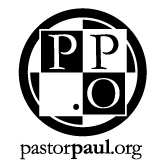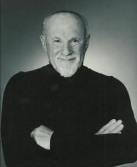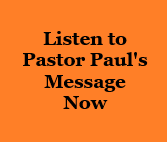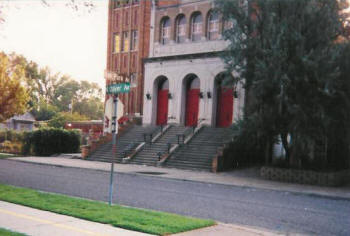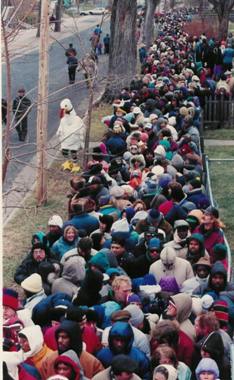The official historic designation by the city of Minneapolis Heritage Preservation Commission was July 16, 1998. Mikro Kodesh was researched by: Garneth O. Peterson, AICP of Landscape Research, for the Minneapolis Heritage Preservation Commission, at 1466 Hythe Street, St Paul, MN 55108. Our Minneapolis HPC Preservation Planner was Amy Lucas.
The historic context developed in conjunction with these designations, "Jewish Settlement in Minneapolis, 1860's-1972," provides a thorough explanation of the history and settlement of Jews in Minneapolis, as well as, how the property relates to this context. The significant role the building played as religious and cultural centers for the neighborhood is also considered. This is a local designation under criteria Gp-1 and Gp-2. The following is taken from the HPC Registration Form pages 4-8.
7. Significance
Mikro Kodesh Synagogue, now Disciples Ministry Church is significant under Heritage Preservation Guideline Gp-1 as an example of the religious and cultural development of the city of Minneapolis. The growth of religious and cultural institutions reflected the needs of various ethnic groups to establish themselves in the city. New immigrants began houses of worship based on their ethnic heritage and use of their native tongue. Mikro Kodesh was an 'immigrant' congregation, and represented the Orthodox branch of Judaism, and particularly Jews of Russian descent. In terms of numbers, Orthodox Judaism predominated in the Minneapolis Jewish community at the turn of the century, and many congregations formed based on ethnic heritage. Like other immigrant congregations, as their members became more Americanized, ethnic heritage became less important. In the Jewish community, this eventually led to mergers with a mixture of ethnicities and sometimes a transition to the Conservative, rather than Orthodox, traditions. With Mikro Kodesh, the merger and change to Conservative traditions did not occur until the congregation left North Minneapolis in 1969.
Mikro Kodesh/Disciples Ministry is also significant under Heritage Preservation Guideline Gp-2 for its reflection of the strong ethnic communities it served. Originally built by the Jewish community, it is one of a few remaining buildings that reflect the once large North Minneapolis Jewish population. When they moved on, this house of worship became Disciples Ministry Church, as African-Americans followed the path of the Jewish population and moved to North Minneapolis. The building represents a center of community that reflected neighborhood changes, and adapted to serve those changes.
As an important example of a house of worship, Mikro Kodesh/Disciples Ministry Church fits with the Religion and Social Organization context and "Jewish Settlement in Minneapolis, 1860s-1972" of the Minneapolis Preservation Plan.
Jewish Settlement in Minneapolis Top
Jewish settlers pioneered in Minnesota prior to statehood, although in small numbers. One historian noted that the state's Jewish population in the 1850s was largely German, had frequently lived in other eastern or southern states prior to Minnesota settlement, and that many came with enough capital to start a business. Mount Zion, the first synagogue in the state, was founded in St Paul in 1856. Minneapolis' first synagogue, Shaarai Tov (Temple Israel) was incorporated in 1878 and comprised largely of early German Jewish settlers. 3
Beginning in the 1880s large numbers of Eastern European Jews arrived and led to the creation of numerous Orthodox synagogues, each serving a different national group such as Lithuanians, Russians, or Romanians. Between 1884 and 1905, 11 Orthodox synagogues were founded in Minneapolis. The city's Jewish population, 5,000 by the turn of the century reached 8,000 by 1910, with about 4,500 residing in North Minneapolis and 3,500 on the South Side. 4
In the post-war years, the general suburban movement affected the old central city neighborhoods and many Jewish families moved to St Louis Park, Golden Valley and Minnetonka. In 1947, 60% of Minneapolis Jews still lived on the North Side. 5 Within two decades, however, virtually all the Jewish institutions there had relocated. Two synagogues remained in South Minneapolis until 1993, when Adath Jeshurun moved to Minnetonka. Today, of the historic congregations, only Temple Israel remains in the city of Minneapolis.
Development of Mikro Kodesh Top
The arrival and movement of Eastern European Jews into North Minneapolis led to the creation of a flurry of congregations. The first was Ohel Jacob (Tent of Jacob), which met above a store at 605 Second Street north from its 1888 beginning. Ohel Jacob lasted only three years, to be succeeded by Kenesseth Israel, organized 1891, which became the center of Jewish activity on the North Side. Two congregations of Russian immigrants organized in 1890: Bes Ha Midrash Ha Gadol, which dissolved after a few years, and Anshei Russia (Men of Russia). 6
In its beginning, the Orthodox Anshei Russia shared Rabbi I. Jaffa with Ohel Jacob synagogue. Because most of its members were peddlers and spent the week in the country selling their wares, the congregation held services only on the Sabbath. The Anshei Russia changed its name to Mikro Kodesh Synagogue in 1895. The congregation stated that it did not want to perpetuate the name of Russia, particularly when that country had treated Jews so poorly and when the congregation now lived in America. 7
The congregation met in a wood frame Greek revival synagogue at Oak Lake and Eighth Aves. N. from 1901. The first generation building was in the heart of the North Minneapolis community. In 1926, Mikro Kodesh, along with Beth El, Temple Israel and Adath Jeshurun, reflected the second generation of growth within the Jewish community and announced plans for a new building. Beth El, at Fourteenth and Penn Av N. and Mikro Kodesh led the movement to the Penn and Plymouth area reflecting movement of the Jewish community north and west through North Minneapolis. Sharei Zedeck moved to 1119 Morgan Ave. N. in 1936, and eventually Kenesseth Israel, the oldest Orthodox congregation located at 2309 Plymouth Ave. N in 1948. 8
Located on the northeast corner of Oliver and Tenth Aves. N. (now Oak Park), the elaborate brick and stone structure was estimated to cost $140,000. Architect Septimus J. Bowler planned the new building to seat 1000, 640 on the main floor and 460 in the balcony. The balcony contained a library and rabbi's study; the basement contained sections for men and for women, a kitchen, and meeting rooms. 9 Top
In 1926, the congregation numbered 100 members, led by Rabbi Moses Romm and Rabbi David Silverstein. The newspaper reported that Mikro Kodesh had its school at 1015 Logan Ave. N. According to one observer, this school was founded to inculcate 'the standards of Orthodoxy' known in the old country, in contrast to the Minneapolis Talmud Torah, which was judged to be too liberal. The Mikro Kodesh school, which never numbered more than 100 pupils, was opposed by laymen , as well as, Orthodox rabbis, who supported the Talmud Torah. By 1945, lowered attendance and finacial support led to the merger of the two schools. 10
A 1936 survey of the Minneapolis Jewish community noted that Mikro Kodesh counted 125 dues-paying members, 99% of whom lived on the North Side. In terms of membership, Mikro Kodesh ranked fifth behind Temple Israel, Beth El, Adath Jeshurun and Kenesseth Israel. The survey noted that Mikro Kodesh held some social and educational functions and had a Young People's League of 100 members, but no library or club rooms. This situation was in contrast to the conservative and reform congregations, which had class and club rooms for more secular activities along with their religious mission. 11
In 1937, Mikro Kodesh installed Shmaryahu T. Swirsky, only 24 years old, as its rabbi. A seventh generation rabbi, Rabbi Swirsky made changes to attract both young people and adults to the synagogue. By 1949, one analyst noted that the congregation was moving away from strict Orthodoxy toward a Conservative approach. The 'ritual of the synagogue' remained Orthodox, 'even though the members are today far less strict in their observances than the early members of the congregation.' 12
In 1942, Rabbi Nahum Schulman joined Mikro Kodesh, and guided its growth from 76 families to 400. By 1949, the congregation was the largest Orthodox Jewish congregation in the Upper Midwest. The growth led to construction of a community building and annex, providing classrooms, clubrooms, study, assembly and dining room, kitchens and display areas. 13 This addition addressed the needs pointed out in the 1936 survey, reflecting the movement of the Orthodox congregation toward the community focus previously seen in the Reform and Conservative congregations. Top
One analyst has stated that although Orthodoxy declined overall, Mikro Kodesh continued to grow, due to its dynamic leadership under Rabbis Swirsky and Schulman. Rabbi Schulman remained until the 1960s when the congregation decided to join the movement to the suburbs. In October, 1967, Mikro Kodesh was Minneapolis' largest Orthodox congregation with over 500 families, 60 to 70% of which no longer lived on the North Side. 14
By November, 1968, newspapers reported that Mikro Kodesh members voted to merge with B'nai Abraham congregation in St Louis Park. B'nai Abraham sold its synagogue at 825 13th Ave. S. in 1956, and with 17 member families moved to St Louis Park. It had expanded and built a synagogue at Highway 7 and Ottawa by 1959. Mikro Kodesh members had previously voted against a merger, largely based on membership of older members who sought to hold to the rule of walking to Sabbath services. The decline in membership was too great, however. Mikro Kodesh had lost half its members in two years, from 1,000 in 1967, to 500 in 1969. Despite the $650,000 the congregation had planned for construction of a new synagogue, they supported the merger. 15
The merger of the Orthodox Mikro Kodesh and the Conservative B'nai Abraham failed after a two-month period. By May, 1969, a merger with Tifereth B'nai Jacob prodeeded. Tifereth B'nai Jacob was also Conservative, but located at 1501 Xerxes Ave. N. The congregations planned to sell their existing North Minneapolis buildings and build a new synagogue in Minnetonka. In 1972,the unified Tifereth B'nai Jacob and Mikro Kodesh combined with B'nai Abraham and created a new congregation, B'nai Emet (Sons of Truth), located today at 3115 Ottawa Ave. S. in St Louis Park. 16
The Mikro Kodesh building remained vacant for about a decade until the nondenominational Disciples Ministry Church purchased and took over the building. Disciples Ministry Church operates a food shelf in the building and also oversees a free weekly food distribution from the enclosed parking lot behind the structure.
Mikro Kodesh, an immigrant synagogue of Russians, paralleled the growth of the North Minneapolis Jewish community. From its first frame synagogue, and then moving west along with the expanding community, Mikro Kodesh grew to become the largest Orthodox congregation in the Upper Midwest. By the 1960s, however, the ethnic heritage and separateness that had fostered the creation of so many synagogues at the turn of the century was no longer important. Similarly, an Americanized congregation no longer sought to follow all the traditions of Orthodoxy. When Mikro Kodesh moved to the suburbs, it joined the Conservative tradition with two other synagogues of Eastern European immigrants who descended from a similar heritage. Top
3. W. Gunther Plaut, The Jews in Minnesota. (New York: American Jewish Historical Society, 1959), 39, 66.
4. Hyman Berman, "The Jews," in June Drenning Holquist, ed. They Chose Minnesota: A Survey of the State's Ethnic Groups. (St Paul: Minnesota Historical Society Press, 1981), 496-497; Rhoda G. Lewin, "Minneapolis Jewish Heritage Remembered," Lake Area News (Dec. 1987): 16b-22b.
5. Berman, 502
6. Albert I Gordon, Jews in Transition. (Minneapolis: University of Minnesota Press, 1949), 156-158.
7. Gordon, 156
8. See Garneth O Peterson, "Jewish Settlement in Minneapolis, 1860s-1972," (1997) context in Minneapolis Preservation Plan, for complete discussion of the various synagogues and their movements.
9. Minneapolis Journal, May 30, 1926, Minneapolis History Collection, Minneapolis Public Library.
10. Gordon, 182-183; Minneapolis Tribune, Sept. 11, 1927, Minneapolis History Collection.
11. George W. Rabinoff, survey director. Minneapolis jewish Communal Survey. 3 vols. (Minneapolis: Auspices Minneapolis Council of Social Agencies, 1936), 24-25
12. Minneapolis Tribune, November 30, 1937, Minnesota History Collection; Gordon, 157.
13. Minneapolis Star, June 25, 1949. Minnesota History Collection
14. Herbert Samuel Rutman, "Defense and Development: A History of Minneapolis Jewry, 1930-1950." (Ph.D dissertation, University of Minnesota, 1970), 75-76; Minneapolis Star, October 12, 1967, Minneapolis History Collection.
15. Minneapolis Tribune, November 25, 1968, Minneapolis History Collection.
16. Minneapolis Tribune, May 17, 1969; Mitchel J. Lazarus and Judith B. Erickson, The Jewish Community of Greater Minneapolis, 1971-1972. (Minneapolis: the Minnesota Federation for Jewish Service, 1972), VII.1.
Mikro Kodesh Synagogue Now
